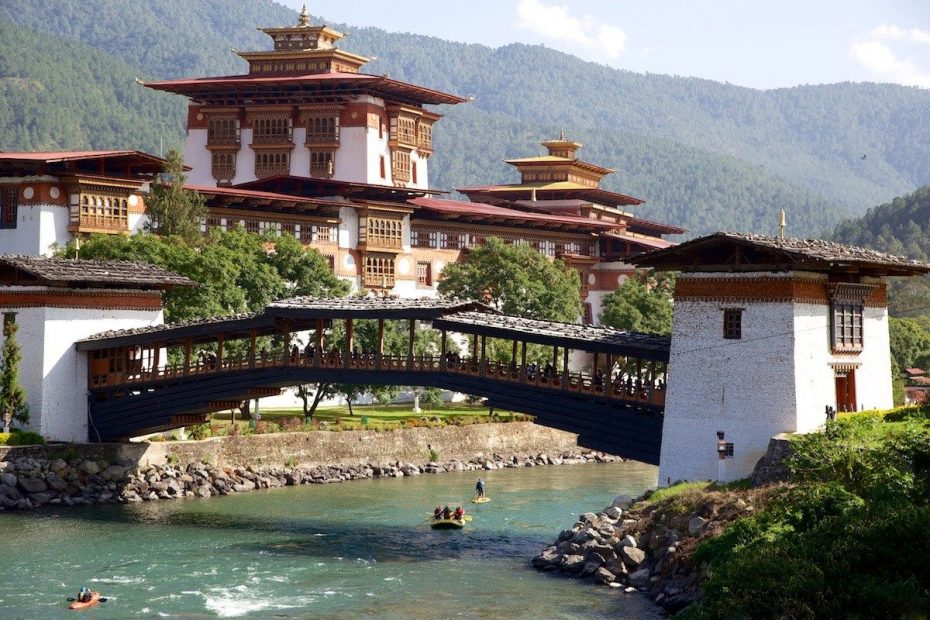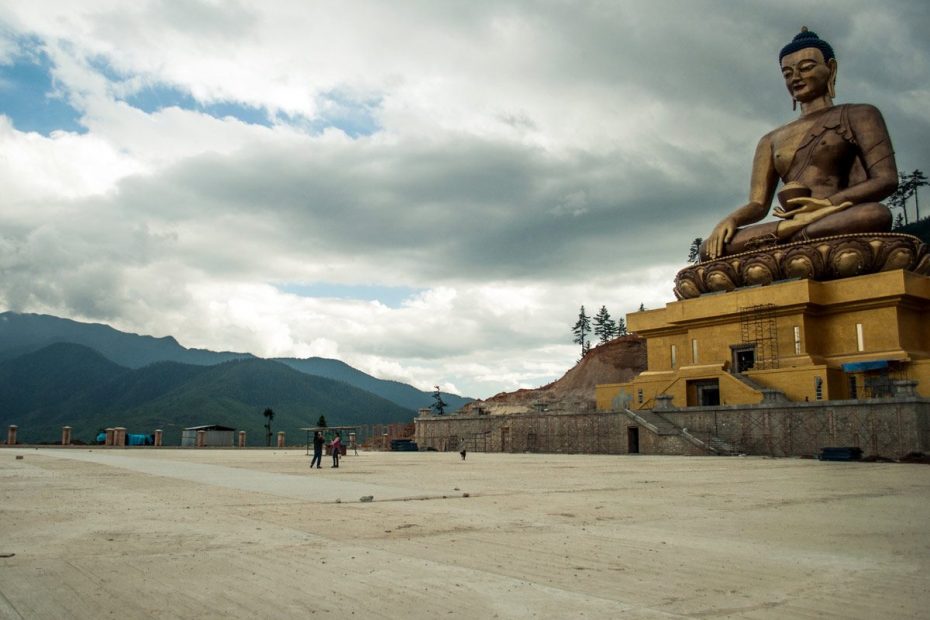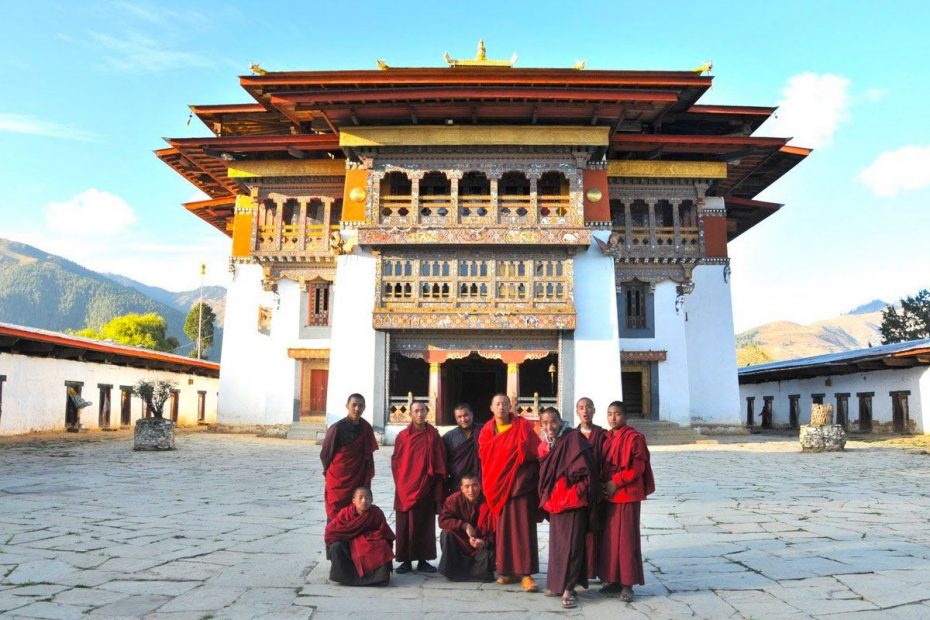Bhutan discovery: nature, communities, and trekking
13 Days
This itinerary is thought as to experience and visit the holy sites of Bhutan that were blessed by Guru Rinpoche during his long journey from India to Tibet in the 8th Century CE and also to get to explore the cultural and ecological richness of Bhutan. Bhutan, unlike its other Himalayan neighbours, considers all creation sacred, including trees, mountains, rivers, and lakes. Consequently, Himalayan species near extinction in the bordering countries of Nepal, India, and Tibet are doing well in Bhutan. Bhutan is also the last bastion of vajrayana Buddhism, a spiritual practice that is known to be one of the most profound schools of teaching in the Buddhist world. The sacred monasteries, the fluttering prayer flags that line the high ridges, the red robed monks chanting their prayers — all give this kingdom an aura of another time.
This is BHUTAN: Known to its inhabitants as Druk Yul — “the Land of the Thunder Dragon. The culture remains vibrant and the environment pristine as Bhutan continues to thrive in the 21st-century. Apart from the majesty and grandeur of the natural surroundings, the environment allows communion with the divine through meditation and contemplation. Bhutan is an abode of Buddhist deities, immortals, and saints in the Himalayas. Scholars wandering yogis, saints and lay pilgrims, have been irresistibly drawn to these remote and rugged mountains throughout the centuries in their search for wisdom and inspiration. Experience the landscapes they have blessed for all pilgrims by following in their footsteps. As you travel to these hidden holy shrines and otherworldly ancient monasteries (Gompas), hiking through an unspoiled Himalayan environment, you will rediscover this peace and solitude. This tour therefore is designed to discovered some of the off-beaten tracks that take every trekker and traveler to some of Bhutan’s most remote and unexplored trekking destinations. However, the trekking experiences we propose in this tour are accessible to everyone, ideally also for beginners, but with good physical and health conditions. The off-beaten treks selected in fact are basically daily hiking with good quality comfort hotels at nights. Only for a couple of nights infrastructure are more basic as to have a first-hand experience with local communities and the environment, sleeping one night in a monastery and another night in a tent.
The scared Paro Taktshang, Tiger Nest is blessed during 7th century, by the great tantric master, Guru Rinpoche, who came here by his miraculous, flying on the back of flaming tigress in form of Guru Dorje Drolo from Khenpajong (eastern Bhutan) on the way from Tibet, to advocate the Buddhism teaching in Mon-Yul (place of darkness). Here, he meditated almost three months and blessed with numerous of Neys (holy site), subdued and activated the evil deities as Buddhism protectors and even the whole locality was also turned into Buddhist. From Pemayangtse monastery, meaning perfect sublime lotus, the beautiful Khachopelri monastery, the unique Bon Monastery of Kewzing and finally to the famous, majestic Tiger’s Nest (Taktsang) balanced among the clouds high above Paro, blessed by Guru Padmasambhava himself, this journey provides a true insight to the rich culture and religiousness of Bhutan.



JOURNEY OVERVIEW AND PROGRAM DETAILS
1° DAY: ARRIVAL IN KOLKATA
Kolkata
Arrival at Calcutta international airport. Transfer to hotel for refreshing and rest. Kolkata, formerly Calcutta, is the capital of the Indian state of West Bengal. Located on the east bank of the Hooghly river, it is the principal commercial, cultural, and educational centre of East India, while the Port of Kolkata is India’s oldest operating port as well as its sole major riverine port. As the former capital of British India, Kolkata retains a feast of colonial-era architecture contrasting starkly with urban slums and dynamic new-town suburbs with their air-conditioned shopping malls. Afternoon short city tour which also includes a country boat ride on the Ganges to experience the glorious sun set.
Overnight in Kolkata (B)
2° Day: FLY TO PARO
Kolkata- Paro-Thimpu
Transfer to airport for flight to Paro, your introduction to our enchanting kingdom begins on a flight over the Himalayas into the lush green valley of Paro; truly one of The world’s most spectacular sights. During your flight, You will view the world’s highest, most majestic peaks and enjoy the view of the approaching valley with its primeval alpine forest, monasteries, temples and farmhouse nestled in splendid mountain isolation. On arrival to Paro you will be received by our representative, the tour guide, and driven to Thimphu, the capital city. The beautiful drive From Paro to Thimphu takes about an hour, following the Paro River till its confluence. After the confluence, you will take the road along the Thimphu river valley till the capital city of Thimphu. check in the hotel. Later part of the day visit the tallest ‘sitting Buddha’ statue, Memorial Chorten, National Animal Takin. Later a visit to CTAS (Choki Traditional Art School) located just north of the capital of Bhutan, in the beautiful mountain valley of Kabesa. Established in 1999, the school trains disadvantaged youth in the traditional skills of drawing, ‘thangka’ painting, weaving, embroidery, sculpture and wood carving. Students live, study, learn skills for their livelihood and work in the school, which is a collection of traditional Bhutanese buildings, white painted, on the side of a sunny hill amid farms and villages. Currently 136 girls and boys attend and they range in ages from 15 to 25. Students typically study for six years at the school. Here you will have the chance to interact with students and learn one of the arts. In the evening. In the late afternoon you will have a chance to discuss about GNH (gross National Happiness) with local experts. Evening free to stroll around Thimphu.
Overnight in Thimpu (B/L/D)
3° Day: HIKE TO CHERI AND TANGO MONASTRIES
Thimpu
After breakfast you will hike to Cheri Goemba monastery Drive 30 minutes to Dodena and hike about 45 minute through beautiful forest trails to Cheri Monastery built in 1620. Cheri Monastery Hike gives you an insight into the natural discovery of Himalayan vegetation. The hiking trail passes through the off-beaten forest where one often gets to spot a variety of birdlife. The hike to this very scenic monastery is steep but relatively short, with several sacred sites scattered throughout the lush forest. Along the way there is a good chance of encountering wild animals (monkeys, deer…). Cheri monastery is one of the main retreat centres and a popular pilgrimage site in the country. Cheri Gompa was founded by Ngawang Namgyal, the Rinpoche who unified Bhutan as one political and spiritual entity. Its main function is as a retreat centre for the Drukpa Kagyu school of Vajrayana Buddhism. You can see a beautiful painting of Guru on the solid rock. Picnic lunch will be served near the river bank near wooden bridge. After lunch we will continue our hiking to Tango Monastry. Tango literally means the ‘horse head’. The legend goes back to the 13th century when Lam Phajo Drugom saw the cliffs, hills, and rocks manifesting into the form of the mandala of Yidam Deity Tandin (Hayagriva); the horse-headed deity. The place holds rich recorded history down to the Drukpa lineage Zhabdru. Enjoy walking on the stone-paved path into the deep wilderness of rhododendron and oak vegetation. In the late afternroon return back to Thimpu for dinner and rest for the overnight.
Overnight in Thimpu (B/L/D)
4° Day: LIVING A DAY IN A MONASTRY
Thimpu –Dodeydra Monastry
After breakfast transfer towards hike to Dodeydra monastery. If you love nature, tranquillity, butterflies and the off beaten track then Dodeydra hike has a lot to offer. This beautiful and easy hike takes you to a hidden land, providing a hiker a sense of awe and wonder and a point of self-reflection along the way. The name Dodeydra has been derived from the split rock from where the Ter (Hidden Treasure) in the form of scripture was discovered. The monastery is beautifully built between the split rock and it has two altars and beautiful paintings on the wall. The monastery also houses a small museum with many historic and religious artifacts and stories attributed to one of the Chief Abbot Jamyang Gyeltshen, considered an acclaimed craftsman who made numerous statues and paintings/murals. There are around 175 monks living here so today you will have a chance to learn how Buddhism is practiced in Bhutan. In the afternoon you will attend a meditation session on Samtha or vipassana. At 6,30 pm you can join the monks for the evening prayer.
Overnight in the Monastery guest house or in a camp site (B/L/D).
5° Day: DRIVE TO TRONGSA
Dodeydra – Trongsa
Early morning you can participate in morning prayer from 5:30 AM to 6:15Am. After breakfast hike to Jungzhina. Then by car continuing to Trongsa. It’s a beautiful drive through lush vegetation and small beautiful villages. After around 50 km you will be on druk wangyal 108 chorten at douchula pass. The pass offers a stunning 360° panaromic view of mountain ranges Enjoy the breathtaking view of Chendebji and Rukubji Village. Check in the Hotel. Late afternoon visit the Majestic Trongsa Dzong and if time permit the Museum just above the Dzong.
Overnight in Tronsga (B/L/D).
6° Day: EXPERIENCE NABJI RURAL LIFESTILE
Trongsa-Monpas-Nabji
Morning after breakfast drive to Monpas village (around 3 hours), a small village where you can immerse yourself in the daily lives and farming chores of the local community while helping them to conserve environment as well as their cultural and historical heritage. Meet the Monpas, originally a hunter/gatherer community who are believed to be first inhabitants of Bhutan. They practice a combination of animistic shamanism and Buddhism. Have lunch in a local house and then transfer to Nabji. In the 8th century Guru Rimpoche came to Bhutan as a mediator between the warring lingks, King sindhu raja of the bumthnag and King nangxchen (big nose) of upper Assam. The peace pact pillar is found in nabji lhakhag 9 temple), the name of the village Nabji is derived from the word Nabbi meaning “to promise “. You will have the chance to join the villagers in their daily farming activity. This tiny village is located amid Jigme Singey Wangchuk National Park and people live mostly out of farming. Visit a farm house and join the preparation of lunch and making of Ara the rice wine.
Overnight in Nabji (B/L/D).
7° Day; TREKKING TO KORPHU VILLAGE
Nabji – Korphu – Nabji
Korphu is a again a small village around 3 hrs hike from nabj. For those who can’t go for trekking there is paved road also to Korphu so they can reach the village by car; while other will reach Khorphu through a farm road. You will get to experience the local community’s first hand. Your travel to such village will give rural communities additional source of income to supplement their live hood from subsistence farming. Afternoon back to Nabji where you can visit Nabji temple in a tsho (offering) ceremony. During the festival of Nabji you will have a chance to enjoy this time with the community watching various dances and celebration by lay monk and villagers. During this occasion you can dress up in Bhutan National costume (Gho for Men and Kira for women).
Overnight in Nabji (B/L/D).
8° Day: MONASTERY VISIT PHOBJIKHA VALLEY
Nabji – Phobjikha
After breakfast, drive towards Phobjikha (around 5 hours) via the scenic Pelela Pass. Upon arrival in the valley, enjoy lunch. After lunch, begin the Phobjikha Nature Hike, starting below Gangtey Gompa near the Mani wall chorten. The trail leads downhill through pine forests, offering panoramic views of the valley where black-necked cranes feed during the winter. Pass through Khewa village, surrounded by potato fields and alpine meadows, and visit the 14th-century Khewa Lhakhang, where you may take time for personal reflection and meditation.
After the hike, visit the Crane Information Centre, which offers insights into the local conservation efforts in collaboration with the RSPN.
Later, visit the Gangtey Monastery, a significant Nyingma institution dating back to the 17th century. At 6:30 pm join the monks for an evening prayer session (from 6:30 to 7:30 pm).
Overnight in Phobjikha (B/L/D).
9° Day: EXPLORE PUNAKHA
Phobjikha – Punakha
In the morning, you will have the opportunity to join the monks at the Shedra for an early morning Thrusel ritual (spiritual cleansing) for self-cleansing of all bad spirits surrounding us and for good luck. Buddhist fumigation is a ritual practiced by the Bhutanese every morning and during special pujas (religious ceremonies). Selected herbs are burnt and holy water (thrue-chhu) is poured over one’s head for purification. It is a common belief that every place has its local protective deity or spirit and the fumigation is to please the spirit and keep the spirit happy. After breakfast drive to Punakha (around 2 hours) check in the hotel. After visit the Majestic Punakha Dzong. Built in 1637-38, this sacred monastery is the second oldest as well as second largest dzong in the Land of Thunder Dragons. The dzong was built by Ngawang Namgyal, the first Zhabdrung Rinpoche. With pictorial mountain peaks as its neighbour, Punakha Dzong is among the soon to be listed as one of the UNESCO World Heritage Sites in Bhuta. A six-storied building with a central tower, it measures up to 180m (in length), 72m (in width) and has three different ‘docheys’ (or courtyards). Later you will have a short hike of 20 minutes to the Chimmi Lhakhag the temple of fertility, the temple is built by drukpa Kinley. In Bhutan, he is also a cultural icon around whom countless yarns of facts and fiction, and stories and legends have been spun.
Overnight in Punakha (B/L/D).
10° Day: TEMPLE VISIT IN PARO
Punakha – Paro
After breakfast drive to Paro. One the way you will stop to have a look at the magnificent view of mountain in dochula pass. Here you can hang the prayer flag. Arrive in Paro check in the hotel and have lunch. After lunch drive to Paro Dzong. The Rinpung Dzong (which means fortress on a heap of jewels) was built in 1644 by Zhabdrung Nawag namgyal. From the dzong walk down to the traditional wooden covered bridge. In the evening a short drive to the oldest and most beautiful Kichu temple, built by Songtshen Gympo in 659. Offer butter lamp in the alter.
Overnight in Paro (B/L/D)
11° Day: BUMDRA TREK
Paro – Sangchhoekor – Bumdra Camp
After breakfast, you will set off on a short scenic drive to Sangchhoekor Buddhist College, located at 2,800 meters on a hilltop overlooking the Paro Valley. Before beginning the trek, you’ll receive a traditional blessing and may have the chance to exchange a few words with the resident monks, many of whom speak basic English. From this peaceful starting point, the trail leads gently uphill through forests of pine and blooming rhododendron. As you ascend, you’ll pass colorful prayer flags fluttering in the breeze and walk across open meadows offering sweeping views over the valley and the distant Himalayan peaks. After approximately three to four hours of hiking, you’ll reach the campsite just below Bumdra Monastery, a sacred site known as the “Cave of a Thousand Prayers.” Here, you can relax, explore the surroundings, or climb a little higher for a spectacular panoramic view of Bhutan’s highlands. Dinner will be served at the camp, followed by a quiet evening under the stars, surrounded by nature’s stillness.
Overnight in tented camp near (B/L/D)
12° Day: HIKE TO TIGER NEST MONASTERY
Paro
Wake early to enjoy a breathtaking sunrise from your high-altitude campsite. After breakfast, begin your descent through peaceful rhododendron and pine forests, following a quiet trail that leads directly to the upper temples of Taktsang Monastery. This exclusive approach allows you to visit the sacred Zangdopelri Temple, with a unique bird’s-eye view of the main monastery below, dramatically clinging to the cliffside. After a moment of reflection and a butter lamp offering, continue down to explore the main sanctuaries of Bhutan’s most iconic spiritual site. At the base, your driver will take you back to Paro. Later visit a farm house where you will be able to see various Bhutanese traditional way of making rice wine, the Zaw, the Suja making (butter tea), learn traditional game of Archery and Degor (play with stone). Evening Enjoy a traditional hot stone bath. Back to hotel for a well-earned rest.
Overnight in Paro (B/L/D)
13° day: DEPART FROM PARO
Paro
Say goodbye to Bhutan and board a flight for onward destinations. We hope you’ll carry this gentle kingdom in your heart: May it brings peace to you and others. Have a safe journey.
ACTIVITIES
- Discover the city of Kolkata,
- explore the cultural and ecological richness of Bhutan
- take part in art and crafts activities in Choki Traditional Arts School
- visit handmade paper factory
- enjoy the 360 degree panoramic view of mountain ranges from Douchula pass
- experience a hot stone bath
- interaction with the local village communities,
- immerse yourself into the bounty of nature with the hike to Tango and Cherri monasteries
- Participate for a full day in the activities of monks in Dodeydra Monastry,
- enjoy a trekking from Nabji to Korphu village
- Have a nice nature trekking in Phobjikha valley
- Enjoy a Thrusel ritual (spiritual cleansing) for self-cleansing of all bad spirits surrounding us and for good luck
- join the Monks in the offering ceremony in Gangtey Monastery
- take a walk through paddy field to Temple of fertility Chimmi Lhakhang temple in Punakha,
- visit temples and Monasteries
- experience an overnight hiking in the campsite just below Bumdra Monastery
- hike to Taksang, the famous Tiger’s Nest Monastery, enjoying unforgettable views of Mount Chomolhari
- enjoy hot stone bath after the Bumdra trekking
SOCIAL AND ENVIRONMENTAL IMPACT
All the itinerary has been designed in order to promote direct or indirect benefits for local communities, environment and cultural heritages. When possible we have selected traditional accommodations sensible to social and environmental issues, following general principles and practices of responsible tourism. The tour is designed to include the activities of various local and tribal communities, through the use of a number of local homestays which get economic support from the trip. Bhutan is a treasure house of indigenous culture, multi ethnic groups and Hill tribes. It’s amazing a small country would have 19 different dialects. Such kind makes Bhutan a unique destination. For the benefit of local community the Bhutan government decide to open few indigenous village for visitor whilst conserving the natural resources and respecting their way of life .which involves communities to be environmentally sustainable, contribute to the community school, library, also conservation of wild life project . Some of these are contribution to the Gross National Happiness (GNH). In Thimpu, the capital of Bhutan, the tour will support the CTAS “Choki Traditional Art School”, whose main mission is to preserve the traditional arts and crafts of Bhutan from fading away, and to empower youth with livelihood skills. This school is the only private institute providing training on traditional arts and crafts in Bhutan. It provides free tuition, food and lodging facilities to the economically disadvantaged youth of Bhutan. By teaching and promoting traditional skills of Bhutan the institute has high potential to create new jobs. Zorin Chusum (Thirteen Crafts) can provide a real source of income and employment. In Thimpu you will also visit a Voluntary Artists’ Studio, known as VAST, which was set up in 1998 by a group of professional artists as a non-profitable and non-governmental organization (NGO). This informal organization was set up with the sole aim of providing an opportunity to the Bhutanese youth to participate and develop their potential talents as well as share social responsibilities through artistic explorations and other socially useful and productive work. Its primary objective is to provide potential vocational skills and alternative positive use of free time and facilitate participation in the national and international art realm. You will have an exposure visit to the youth centenary village, part of “Simply Bhutan”, a unique project of the Bhutan Youth Development Fund. This institution runs programs in order to build leadership skills, encourage teamwork and promote the value of service among youth. Through advocacy work and strategic partnerships, the Fund works to encourage youth participation, raise awareness of youth issues and promote youth-oriented policy. We invest in Bhutan’s future, one youth at a time.
TIPS BEFORE DEPARTURE
A conscious approach to travel requires a considerable capacity and willingness to adapt and adjust to the local environment and culture. If you wish to travel with us we request you to be open enough to experience local culture, religious and traditions without bias and pre-conceived ideas you might have before the departure and which belong to our Western cultural way of thinking. Exploring with fresh eyes, with patience and openness, you will be able to access the real essence of the cultural heritages and spirituality through the places and people you are going to meet; if you are ready to do this effort you will really enjoy the beauty of the rich culture and religiousness of Bhutan, the extraordinary of the nature, the solemnity of Buddhist monasteries and the holy sites blessed by Guru Padmasambhava himself. In Bhutan the weather could get wet with sporadic or long showers. Please pack appropriate clothing. Bhutan’s changeable climate means you have to bring an assortment of clothes, including rain gear. Mornings and evenings could be quite cold. Carry with you appropriate warm clothing especially for the evening. A layered wardrobe probably makes the most sense. However, warm clothing is required throughout but more specifically from October to April. Good walking shoes or hiking boots are essential even if you are not hiking. Because of the altitude, a hat or cap and a good pair of sunglasses are essential. Because of the long distances between towns and villages bring the medicines you’ll need along with some first-aid supplies. A good flashlight (torch), water bottle and polarizing filter for your camera will also come in very handy. A backpack is necessary to carry essentials/cameras while you are on local excursions. Monasteries and temples are places of worship, so you should be dressed accordingly. Admission might be denied to men and women wearing short pants/skirts, sleeveless t-shirts/blouses. Getting to Bhutan is not quite straightforward. The Bhutanese Government monitors visitors into and out of Bhutan. On entry into Bhutan, you will meet an official recognised guide, who will escort you everywhere. He will be with you until you depart. You are strongly recommended to engage with us at an early stage of you are planning to visit Bhutan during Festival periods. This itinerary offers good opportunities for cultural exchange, adventure, hiking, wildlife spotting and moderate trekking. However it is not fit for everyone, due to moderate trekking and altitude. Check with your physician to confirm that you are healthy to travel. Inform your doctor where you are going to see if there are any special concerns. Because of the climate and general lack of medical facilities in the villages, you should be reasonably fit before departure.
HOTELS
In Bhutan, we have selected mid category hotels and homestays with all the major facilities and comforts but in the true tradition of Bhutanese hospitality. While Nabji village the hotel have very basic facilities and in Gelephu the eco-camp as a couple of bamboo cottage and tents.
TRANSPORT
We will be using comfortable and air-conditioned mini-coach/van throughout the entire trip.
WHEN TO GO
It is possible to visit Bhutan all year around but the best weather is generally:
Mar–May (spring)/ MidSep–MidNov (autumn). Spring (March April & May) is the most beautiful time of the year, resplendent and ablaze with a spectacular array of bright colours. Also, it is the time to witness the famous Paro tsechu festival. The Paro Tshechu is held every spring and is one of the most colourful and significant events in Paro Dzongkhag (district). Autumn (September, October & November) is lovely with clear and crisp blue skies, providing a grand view of some of the tallest unclimbed mountains in the world. It is the best time for trekking and for travelling. This is instead the right time to assist to the Thimphu tsechu festival!

